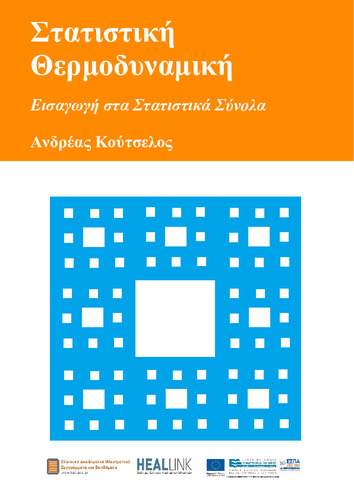| Title Details: | |
|
STATISTICAL THERMODYNAMICS |
|
| Authors: |
Koutselos, Andreas |
| Reviewer: |
Diakonos, Fotios |
| Subject: | NATURAL SCIENCES AND AGRICULTURAL SCIENCES > CHEMISTRY > PHYSICAL CHEMISTRY NATURAL SCIENCES AND AGRICULTURAL SCIENCES > PHYSICS > GENERAL PHYSICS > STATISTICAL PHYSICS AND THERMODYNAMICS NATURAL SCIENCES AND AGRICULTURAL SCIENCES > CHEMISTRY > PHYSICAL CHEMISTRY > THERMODYNAMICS NATURAL SCIENCES AND AGRICULTURAL SCIENCES > CHEMISTRY > PHYSICAL CHEMISTRY > ENTROPY NATURAL SCIENCES AND AGRICULTURAL SCIENCES > CHEMISTRY > PHYSICAL CHEMISTRY > ENTHALPY NATURAL SCIENCES AND AGRICULTURAL SCIENCES > CHEMISTRY > PHYSICAL CHEMISTRY > EQUATION OF STATE NATURAL SCIENCES AND AGRICULTURAL SCIENCES > CHEMISTRY > PHYSICAL CHEMISTRY > KINETIC THEORY |
| Keywords: |
Statistical Thermodynamics
Statistical Mechanics Fluctuations Statistical Ensembles Quantum Statistics Imperfect Gases Kinetic Theory Of Gases Kinetic Processes |
| Description: | |
| Abstract: |
The theory of statistical thermodynamics reproduces the macroscopic properties of matter based on the microscopic molecular interactions. This depends on the statistical laws which produce the complex behavior of the macroscopic systems from the simpler interaction potentials. The theory predicts the state laws, the mean molecular structure and the dynamics of matter. Conversely, the macroscopic data can be reduced to microscopic information such as the intermolecular potentials. The latter can be used for the calculation of other equilibrium and kinetic properties of matter. The theory is applied to molecular systems in equilibrium, such as the ideal and real gases, liquids, crystals, electron and phonon gases, quantum systems, etc
Similarly, the development of computer programming permits the simulation of thermodynamic systems with the calculation of the particle positions in time and their analysis based on statistical mechanics. This new approach for the calculation of macroscopic properties through molecular dynamics simulation and the stochastic Monte Carlo method is useful for the prediction of properties and the determination of microscopic interactions from experimental data. . |
| Table of Contents: |
1. Introduction
2. Thermodynamics 3 Basic Probability Theory 4. Mechanics 5. Kinetic Theory of Gases 6. Statistical Ensembles 7. Canonical Ensemble 8. Grand Canonical Ensemble 9. Generalized Ensembles 10 Polyatomic Molecules 11. Interacting Systems 12. Molecular Simulation |
| Linguistic Editors: |
Klada, Nektaria |
| Technical Editors: |
Zinas, Nikolaos |
| Type: |
Undergraduate textbook |
| Creation Date: | 2015 |
| Item Details: | |
| ISBN |
978-960-603-396-4 |
| License: |
http://creativecommons.org/licenses/by-nc-nd/3.0/gr |
| Handle | http://hdl.handle.net/11419/5053 |
| Bibliographic Reference: | Koutselos, A. (2015). STATISTICAL THERMODYNAMICS [Undergraduate textbook]. Kallipos, Open Academic Editions. https://hdl.handle.net/11419/5053 |
| Language: |
Greek |
| Consists of: |
1. STATISTICAL THERMODYNAMICS: Introduction 2. Thermodynamics 3. Mechanics 4. Basic Probability Theory 5. Kinetic Theory of Gases 6. Statistical Ensembles 7. Canonical Ensemble 8. Grand Canonical Ensemble 9. Generalized Ensembles 10. Polyatomic Molecules 11. Interacting Interactions 12. Molecular Simulation |
| Number of pages |
243 |
| Version: |
1st ed. |
| Publication Origin: |
Kallipos, Open Academic Editions |


